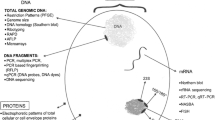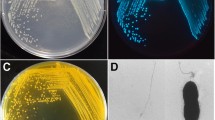Abstract
Faecal samples were collected from impounded stray dogs, classified as under or over six months of age, on their arrival in kennels and again 5–7 days later. The faeces were examined for the presence of campylobacters, salmonella andGiardia lamblia. No significant difference was found in the rate of isolation of these organisms between the two age groups. There was, however, a significant increase in the rate of isolation at days 5–7 compared with day 1. It is suggested that while dogs may acquire campylobacter infection in kennels, excretion of the organism may be intermittent and may be precipitated by stress. A low incidence of salmonellae andGiardia lamblia excretion was detected.
Similar content being viewed by others
References
Barlough, J.E., 1979. Canine giardiasis: a review. Journal of Small Animal Practice, 20: 613–623.
Blaser, M., Cravens, J., Powers, B.W., and Wang, W.L., 1978. Campylobacter enteritis associated with canine infection. Lancet, 2: 979–981.
Borland, E.D., 1975. Salmonella infection in dogs and cats, tortoises and terrapins. Veterinary Record, 96: 401–402.
Bruce, D., Zochowski, W. and Fleming, G.A., 1980. Campylobacter infections in cats and dogs. Veterinary Record, 107: 200–201.
Burrows, R.B. and Lillis, W.G., 1967. Intestinal protozoan infections in dogs. Journal of the American Veterinary Medical Association, 150: 880–883.
Buxton, A. and Fraser, G., 1977. Animal Microbiology. Blackwell, London, pp. 103–115.
Cowan, S.T., 1974. Cowan and Steel's Manual for the Identification of Medical Bacteria. University Press, Cambridge, 238 pp.
Cruikshank, R., 1965. Medical Microbiology. Livingstone, Edinburgh, pp. 221–237.
Ewing, G.O. and Aldrete, A.V., 1973. Canine giardiasis presenting as chronic ulcerative colitis: a case report. Journal of the American Animal Hospital Association, 9: 52–55.
Fleming, M.P., 1980. Incidence of campylobacter infection in dogs. Veterinary Record, 107: 202.
Galton, M.M., Scatterday, J.E. and Hardy, A.V., 1952. Salmonellosis in dogs. Journal of Infectious Diseases, 91: 6–11.
Gruffydd-Jones, T.J., Marston, M., White, E. and French, A., 1980. Campylobacter infections in cats and dogs. Veterinary Record, 107: 294.
Hastings, D.H., 1978. Campylobacter enteritis in pets. Lancet, 2: 1249–1250.
Holt, P.E., 1980). Incidence of campylobacter, salmonella and shigella infections in dogs in an industrial town. Veterinary Record, 107: 254.
Hosie, B.D., Nicolson, T.B. and Henderson, D.B., 1979. Campylobacter infections in normal and diarrhoeic dogs. Veterinary Record, 105: 80.
Khan, A.Q., 1970. Salmonella infection in dogs and cats in the Sudan. British Veterinary Journal, 126: 607–612.
Merritt, A.M., 1980. Small intestinal diseases. In: N.V. Anderson (Editor), Veterinary Gastroenterology. Lea and Febiger, Philadelphia, pp. 463–522.
Morse, E.V. and Duncan, M.A., 1975. Canine salmonellosis: Prevalence, epizootology, signs and public health significance. Journal of the American Veterinary Medical Association, 167: 817–820.
Murdoch, D.B., 1979. Alimentary tract and associated glands. In: E.A. Chandler, J.M. Evans, W.B. Singleton, F.G. Startup, J.B. Sutton and W.D. Tavernor (Editors), Canine Medicine and Therapeutics. B.S.A.V.A., Blackwell London, pp. 285–315.
Pfeiffer, H. and Supperer, R., 1976. Über den Giardia-Befall der Hunde und sein Auftreten in Österreich. Wiener Tierärztliche Monatschrift, 63: 1–6. (Abstract 3723, Veterinary Bulletin, Weybridge, 1976).
Ridley, D.S. and Hawgood, B.C., 1956. The value of formol-ether concentration of faecal cysts and ova. Journal of Clinical Pathology, 9: 74–76.
Sandstedt, K. and Wierup, M., 1981. Concomitant occurrence of campylobacter and parvoviruses in dogs with gastroenteritis. Veterinary Research Communications, 4: 271–273.
Simpson, J.W., Burnie, A.G., Ferguson, S. and Telfer Brunton, W.A., 1981. Isolation of thermophilic campylobacters from two populations of dogs. Veterinary Research Communications, 5: 63–66.
Skirrow, M.B., 1977. Campylobacter enteritis: a “new” disease. British Medical Journal, 2: 9–11.
Sugano, H. and Ando, K., 1978. Giardiasis in dogs. Journal of the Japanese Veterinary Medical Association. 31: 635–638.
Wolff, K. and Eckert, J., 1979. Giardia-Befall bei Hund und Katze und dessen möglich Bedentung für den Menschen. Berliner und Münchener Tierärtzliche Wochenschrift, 92: 479–484. (Abstract 3491, Veterinary Bulletin, Weybridge, 1980).
Author information
Authors and Affiliations
Rights and permissions
About this article
Cite this article
Burnie, A.G., Simpson, J.W., Lindsay, D. et al. The excretion of campylobacter, salmonellae andGiardia lamblia in the faeces of stray dogs. Vet Res Commun 6, 133–138 (1983). https://doi.org/10.1007/BF02214905
Accepted:
Issue Date:
DOI: https://doi.org/10.1007/BF02214905




